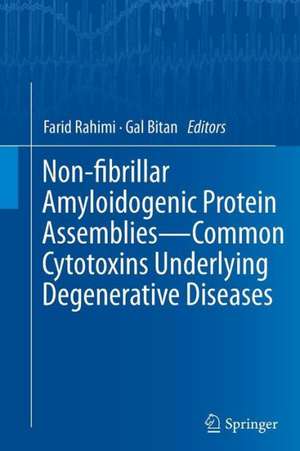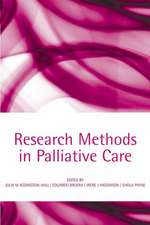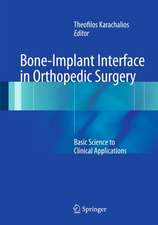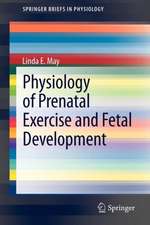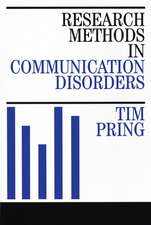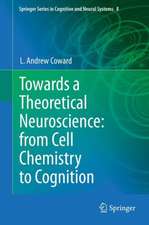Non-fibrillar Amyloidogenic Protein Assemblies - Common Cytotoxins Underlying Degenerative Diseases
Editat de Farid Rahimi, Gal Bitanen Limba Engleză Paperback – 24 feb 2014
| Toate formatele și edițiile | Preț | Express |
|---|---|---|
| Paperback (1) | 1424.89 lei 43-57 zile | |
| SPRINGER NETHERLANDS – 24 feb 2014 | 1424.89 lei 43-57 zile | |
| Hardback (1) | 1429.44 lei 43-57 zile | |
| SPRINGER NETHERLANDS – 13 ian 2012 | 1429.44 lei 43-57 zile |
Preț: 1424.89 lei
Preț vechi: 1499.88 lei
-5% Nou
Puncte Express: 2137
Preț estimativ în valută:
272.66€ • 285.39$ • 226.93£
272.66€ • 285.39$ • 226.93£
Carte tipărită la comandă
Livrare economică 31 martie-14 aprilie
Preluare comenzi: 021 569.72.76
Specificații
ISBN-13: 9789400798953
ISBN-10: 9400798954
Pagini: 576
Ilustrații: VIII, 568 p.
Dimensiuni: 155 x 235 x 30 mm
Greutate: 0.79 kg
Ediția:2012
Editura: SPRINGER NETHERLANDS
Colecția Springer
Locul publicării:Dordrecht, Netherlands
ISBN-10: 9400798954
Pagini: 576
Ilustrații: VIII, 568 p.
Dimensiuni: 155 x 235 x 30 mm
Greutate: 0.79 kg
Ediția:2012
Editura: SPRINGER NETHERLANDS
Colecția Springer
Locul publicării:Dordrecht, Netherlands
Public țintă
ResearchCuprins
1. Overview of Fibrillar and Oligomeric Assemblies of Amyloidogenic Proteins.- 2. Pathologic Lesions in Alzheimer disease and Other Neurodegenerative Diseases—Cellular and Molecular Components.- 3. Preparation and Structural Characterization of Pre-fibrillar Assemblies of Amyloidogenic Proteins.- 4. Biological Targeting and Activity of Pre-fibrillar Aβ Assemblies.- 5. The Role of Aβ and Tau Oligomers in the Pathogenesis of Alzheimer’s disease.- 6. Oligomers of α-Synuclein in the Pathogenesis of Parkinson’s Disease.- 7. Cytotoxic Mechanisms of Islet Amyloid Polypeptide in the Pathogenesis of Type-2 Diabetes Mellitus (T2DM).- 8. Protein Misfolding and Toxicity in Amyotrophic Lateral Sclerosis.- 9. Structural Studies of Prion Proteins and Prions.- 10. Role of Prion Protein Oligomers in the Pathogenesis of Transmissible Spongiform Encephalopathies.- 11. When More Is Not Better: Expanded Polyglutamine Domains inNeurodegenerative Disease.- 12. Protein Misfolding and Toxicity in Dialysis-Related Amyloidosis.- 13. Transthyretin Aggregation and Toxicity.- 14. Strategies for Inhibiting Protein Aggregation: Therapeutic Approaches to Protein-Aggregation Diseases.
Textul de pe ultima copertă
Aberrant protein folding and self-assembly underlie over 30 human diseases called amyloidoses, for which currently there is no cure. The diseases range from tissue-specific to systemic and from genetic to sporadic. Some of the most devastating amyloidoses are those that affect the central nervous system (CNS), such as Alzheimer’s disease (AD), Parkinson’s disease (PD), prionoses (e.g., mad-cow disease), and amyotrophic lateral sclerosis (Lou Gehrig’s disease). In each disease, one or more proteins self-associate into toxic oligomers that disrupt cellular function and communication, and proceed to form insoluble amyloid aggregates characterized by fibrillar morphology and cross-β structure.
The first decade of the 21st century has brought with it significant progress in our understanding of amyloid diseases, including the physiological and pathological processes involving each of the offending proteins. Important developments also provide now improved diagnoses of different amyloidoses and new approaches are being developed towards disease-modifying therapies. This book covers the current state-of-the-art knowledge on amyloidoses as a general phenomenon and offers detailed reviews of individual amyloid-forming proteins and specific diseases.
Features:
The first decade of the 21st century has brought with it significant progress in our understanding of amyloid diseases, including the physiological and pathological processes involving each of the offending proteins. Important developments also provide now improved diagnoses of different amyloidoses and new approaches are being developed towards disease-modifying therapies. This book covers the current state-of-the-art knowledge on amyloidoses as a general phenomenon and offers detailed reviews of individual amyloid-forming proteins and specific diseases.
Features:
- Coverage of the pathologic and pathogenic structures of amyloidogenic proteins from the pathological lesions to the evasive oligomers that are believed to be the main culprits.
- Detailed discussions of diseases of epidemic proportion, such as Alzheimer’s disease, Parkinson’s disease, and type-2 diabetes. Current reviews of multiple diseases, including amyotrophic lateral sclerosis, prionoses, expanded polyglutamine diseases, dialysis-related amyloidosis, and transthyretin-related amyloidoses.
- Mechanism-based strategies for inhibiting protein aggregation and potential therapeutic applications in different diseases.
Caracteristici
An up-to-date review of protein-misfolding diseases which will serve as a complete reference point for readers Up-to-date chapters that discuss different diseases associated with protein misfolding and neurodegeneration A good reference collection for a broad spectrum of readers
